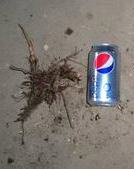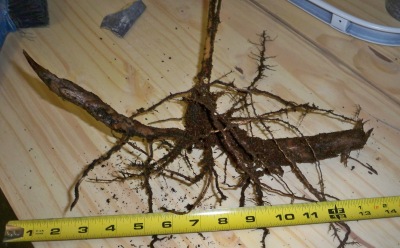Miscanthus Giganteus

1/2 gallon size
Each 1/2 gallon field grown division will differ in size, but will be at least the size of the palm of your hand and have 2-3 rhizomes. 1/2 gallon divisions would fill a 1/2 gallon pot, if potted up. Each root division is variable in size, but the rhizomes will be at least the size of a finger, with some being as large as 14 inches or more, as seen in the second photo below. Rhizomes are the thick, woody portion of the root system. These rhizomes will have “eyes”, similar in appearance to potatoes eyes. These eyes are the areas where new growth will accure.
Rhizomes are similar to bulbs in that they store up the nutrient made through the growing season and are ready to grow a new plant the following growing season. Making a plant bare root disturbs the feeder root system, the finer roots of the plant. These will re grow in spring and fertilization the first season will help these establish. Once plants are established there is little need to fertilize.
Bare root divisions greatly reduce the shipping costs of this plant and is not detrimental to the plant itself. Plants are packed in plastic bags with moistened peat moss. Peat moss is much lighter weight than normal soils and helps the plant ship well and allows the plant to be held in this fashion for several weeks if needed before planting. To keep plants in a more dormant state, place in a area out of sunlight and heat. Smaller shipments can be held in the refrigerator, so long as the bag is tightly shut to keep moisture in. When holding shipments for later planting always check the moisture level of the plants making sure they are slightly damp, not sopping wet. Too wet conditions will cause the woody roots to rot or mold.

| Quantity | Price per 1/2 gallon division |
| 1000+ | $2.39 |
| 101-999 | $2.59 Call for availability on orders of 100 or above. |
| 11-100 | $2.79 |
| 6-10 | $2.89 |
| 1-5 | $2.99 |
For more information about miscanthus as a bio fuel visit:
University of Illinois Miscanthus Giganteus Research
Miscanthus Giganteus report prepared for US Department of Energy
Miscanthus giganteus is a large perennial grass, growing 12-14 ft annually. Potentially the "ideal" energy crop because of its annual cropping cycle and high yields. Here are some of the facts:
1 acre of Miscanthus Giganteus can produce the equivalent energy of 35 barrels of crude oil per year. This grass averages 10-25 tons of dry biomass per acre yearly with good rainfall. (takes 4000 plants to establish an acre)
It is a perennial crop and will produce indefinitely with very little input. Dividing will help plant vigor. (Potato harvesters are used)
Miscanthus has a harvest window between fall and spring, harvest at your convenience. Left standing through the winter the plant dries to 15% moisture level and needs no further drying as corn and wood do, to burn.
The plant requires no pesticides or fertilizer, this is due to the fact that they simply store up the nutrients that they manufacture (much like a bulb does). It will overtake weeds once established and weed control to establish simply uses turf type herbicides.
This grass is the most cost effective to pellitize, folks are making their own pellets and heating their homes and business.
The grass can be stacked and stored in the field for ease of storage. It will not rot and is the best bedding material known as well.
Miscanthus can be co-fired with existing coal boilers. It is being used in ethanol production and grants of up to 75% of seeding fields are available through the federal government. You must be within a short distance of a plant set up to process this type of ethanol to qualify. Up to $45 a ton as added payment to the farmer when delivered to one of these facilities is available through the B-CAP grants the government has set up for alternative fuel production.
More Facts
Miscanthus Giganteus is a sterile plant, non invasive, but only grows from root divisions. It can be grown on marginal land, as it uses its own nutrients that have been manufactured by the plant. It is a vigorous plant, roughly quadrupling in a years time! Hardy zones 4-9, it is cold hardy. This plant likes lots of water to become established, but thereafter is quite drought tolerant. When field planting one should plan on having adequate irrigation for the first year. It does not grow well in waterlogged sites and its woody roots can rot in these conditions. Harvested as hay is, it is cut and baled.
Planting information for making hedges:
Plant 1/2 gallon field grown divisions at a spacing of 3' apart. At this planting rate you should have a hedge with large clumps almost touching one another in 3 years time.
If your budget allow for closer spacing, plant up to 1' apart. This will create a fuller hedge in a shorter time, roughly 1-2 years. Plants can also be placed in rows, one behind the other and plants staggered to create a fuller hedge in less time. How you choose to plant depends on your budget.
Plant divisions 6” deep in well worked soil. Cover and mulch. You may choose to fertilize the first year with basic 12-12-12 fertilizer or a product like miracle grow. After the first year fertilization does not seem to speed up growth as all the plant needs is stored in the root system after a years growth. This grass likes lot of water and should have supplemental water for the first season to become established.
Dividing grass:
Plan to divide your plants every 3-5 years if you desire a clumped effect in the landscape. If left for too many years your clump will become very large and be hard to lift manually. Generally the whole clump is lifted as the roots become very woody and entangled and cannot be cut apart by simply shoveling a portion out. A saw or ax is helpful in dividing the clump, we use an electric saws all.
Even if you wish for a full field like planting, we feel dividing off of your clumps helps rejuvenate the plant as the roots tend to choke the center of the plant out. It will continue to grow outwards, but giving the plant more room to grow all around seems to be beneficial to the plant and will give you more roots to fill in other areas if desired.
At this time online ordering is available for Miscanthus Giganteus, Intersectional Peonies and Herbaceous Peonies. For information on any other plants please contact us at kathy@lacycreekgrowers.com, or by phone (517) 726-0026.
Browse through what is available at our nursery for pickup only. When purschasing items from our nursery in person we only except cash or checks.
Fill out our mail order form and include a check or money order. Download Printable Order Form >>



